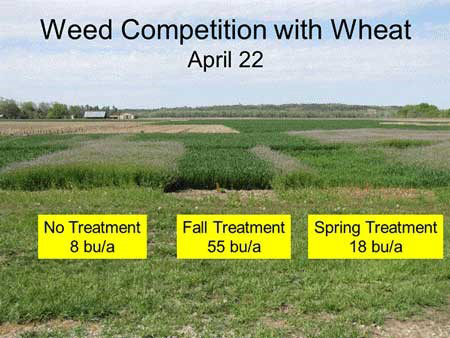Mustard plants such as field pennycress, bushy wallflower (treacle mustard), flixweed, tansy mustard, and blue mustard in wheat fields are often not noticed until the mustards bloom in the spring. As a result, farmers often do not think about control until that time. Although it is possible to get some control with spring herbicide applications, mustard control is much more effective before they have flowered. Earlier applications are also more effective in preventing wheat yield loss due to mustard interference (Figure 1).

Figure 1. Effect of herbicide application timing on blue mustard control in wheat. Photos by Dallas Peterson, K-State Research and Extension.
Herbicide options
To minimize yield losses, mustards should be controlled by late winter or very early spring before the stems begin to elongate or bolt. If mustards are present in the fall, they can be controlled by various active ingredients. Look for products containing Group 2 herbicides such as chlorsulfuron (Glean, others), metsulfuron (Ally, others), triasulfuron (Amber, others), propoxycarbazone (Olympus, others), or pyroxsulam (PowerFlex, others), and premixes of thifensulfuron plus tribenuron (Affinity and others). Most ALS-inhibiting herbicides control winter annual mustards very well. However, there are populations of bushy wall flower and flixweed in Kansas that are ALS-resistant and cannot be controlled by these products. Alternative herbicides will be needed to control these populations. Also, be aware that some Group 2 herbicides have long rotation intervals for other crops.
Group 27 herbicides like Huskie (pyrasulfotole) or Talinor (bicyclopyrone) can control ALS-resistant mustards. Other options to control ALS-resistant mustards are Group 4 herbicides like 2,4-D and MCPA. Dicamba and fluroxypyr (Starane, others) are not very effective for mustard control. Quelex (halauxifen plus florasulam) and Tarzec (halauxifen plus pyroxsulam) are also labeled for control of some mustard species.
Group 27 and Group 4 herbicides have little to no residual activity; thus, they will only control emerging and growing weeds. Applying them with fertilizer in January or February when weeds are dormant will not provide good mustard control. In addition, special care should be taken to ensure wheat is fully tillered when 2,4-D is applied to avoid reducing tillering.
For additional information about these herbicides, see the “2024 Chemical Weed Control for Field Crops, Pastures, and Noncropland” guide, K-State publication SRP-1183 or check with your local K-State Research and Extension office for a paper copy.
Application timing for troublesome species
In the late winter or early spring, blue mustard is perhaps the most difficult of the winter annual broadleaf weeds to control because it bolts very early. To be effective on blue mustard, herbicides typically need to be applied in late February or early March. Blue mustard is more difficult to control than tansy mustard with 2,4-D because blue mustard has often already bolted by the time 2,4-D can be safely applied to wheat. Thus, 2,4-D is often applied too late to be effective on blue mustard.
Flixweed and tansy mustard should be treated when they are no larger than two to three inches across and two to three inches tall. As these plants become larger, control decreases dramatically. Ester formulations of 2,4-D and MCPA are more effective on tansy mustard and flixweed than amine formulations. Field pennycress is easier to control than tansy mustard or flixweed. Herbicide applications made before the pennycress bolts are usually effective.
For help in identifying the different mustard species, please see the article “World of Weeds: Mustard species” in the eUpdate archive at https://eupdate.agronomy.ksu.edu/article/world-of-weeds-mustard-species-485-3.
Non-chemical methods
Crop rotation with corn, grain sorghum, soybeans, cotton, or sunflowers is a good way of managing mustards as long as they are controlled in the spring before producing seeds. Crop rotation will usually result in a gradual reduction of mustard populations in the future as the seed bank in the soil decreases.
Prevention is also a helpful strategy for the long-term management of mustards. Managing mustards in roadsides and field borders can prevent movement into cultivated fields. Also, cleaning equipment when moving from infested to non-infested fields reduces mustard dispersal.
The use of trade names is for clarity to readers and does not imply endorsement of a particular product, nor does exclusion imply non-approval. Always consult the herbicide label for the most current use requirements.
Sarah Lancaster, Weed Management Specialist
slancaster@ksu.edu
Jeremie Kouame, Weed Scientist, Agricultural Research Center – Hays
jkouame@ksu.edu